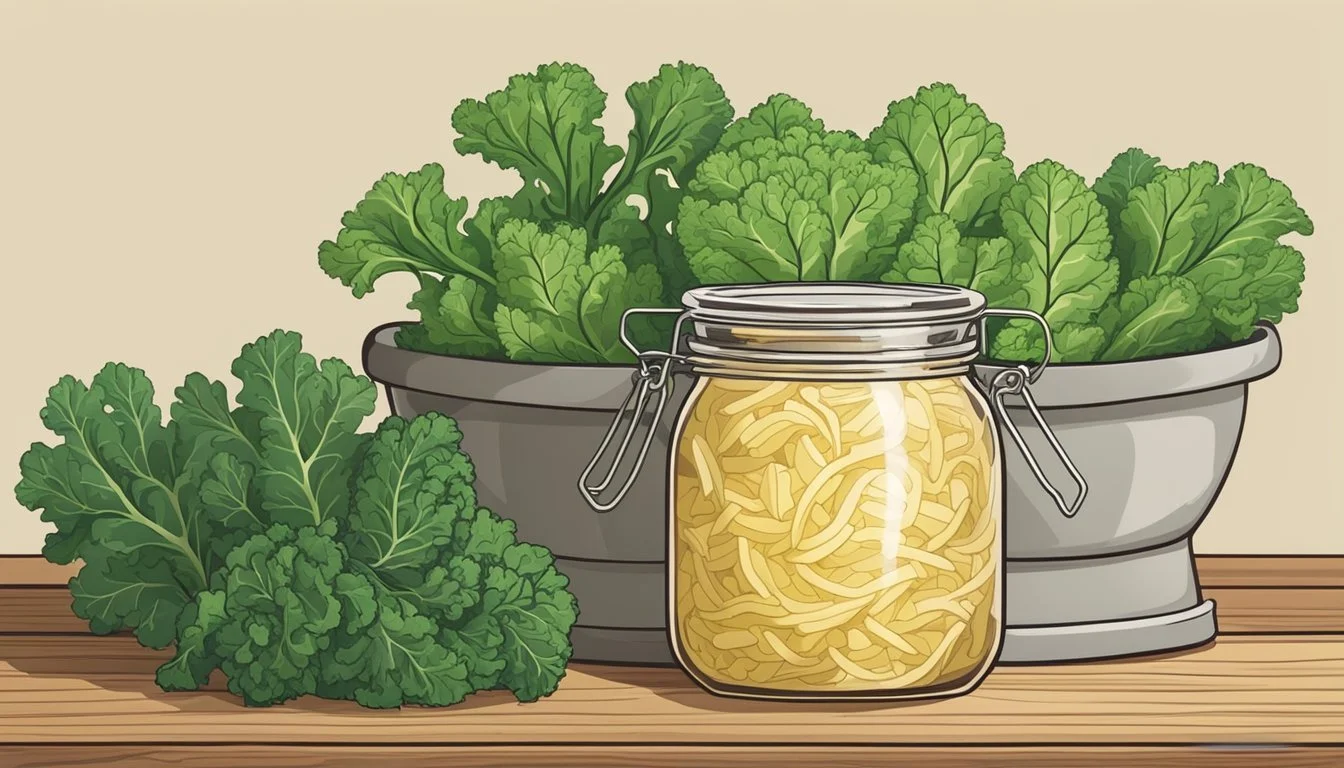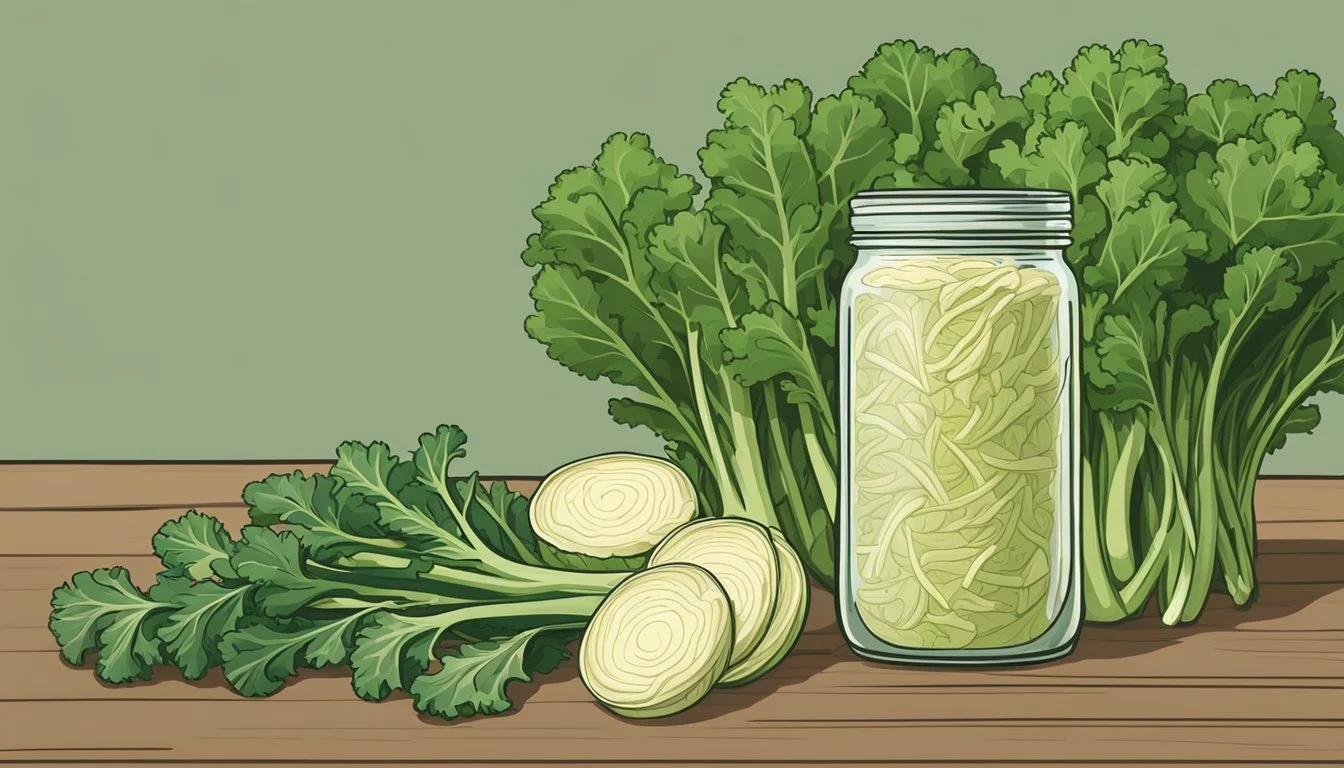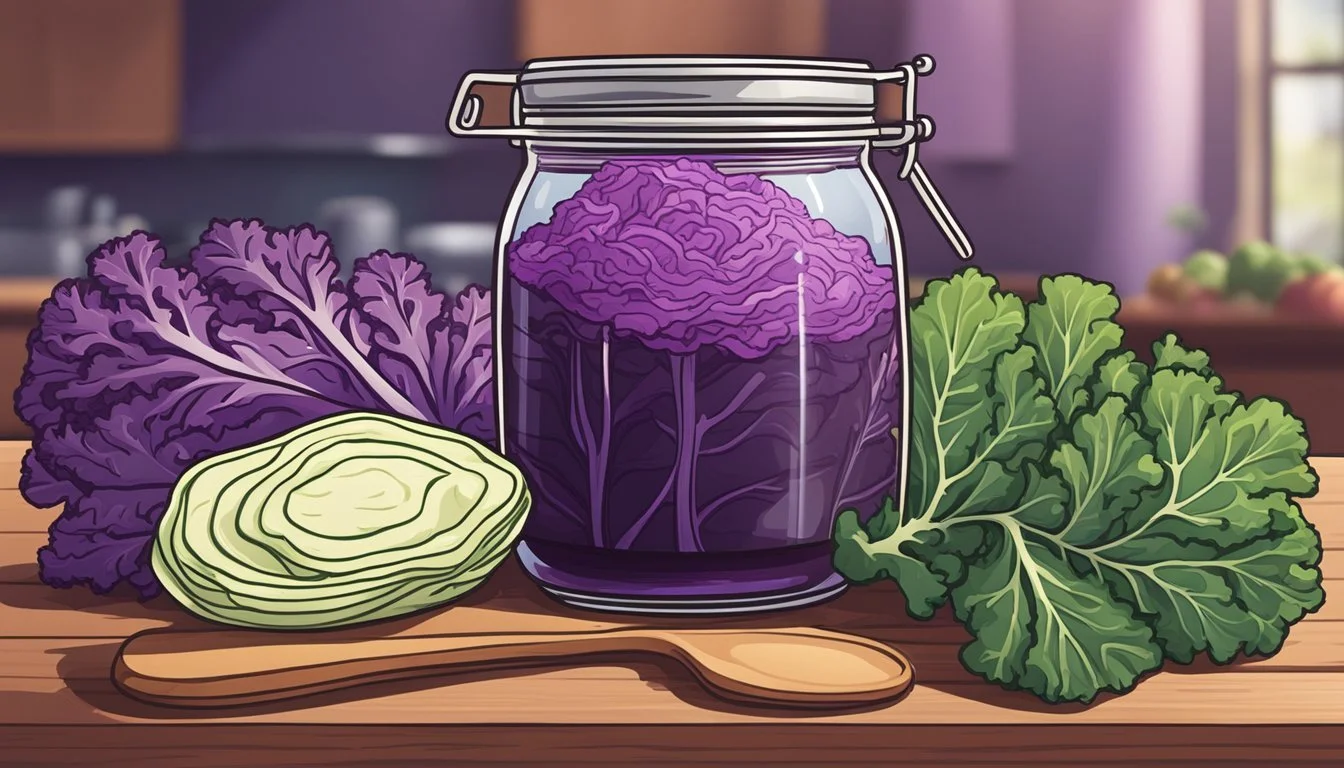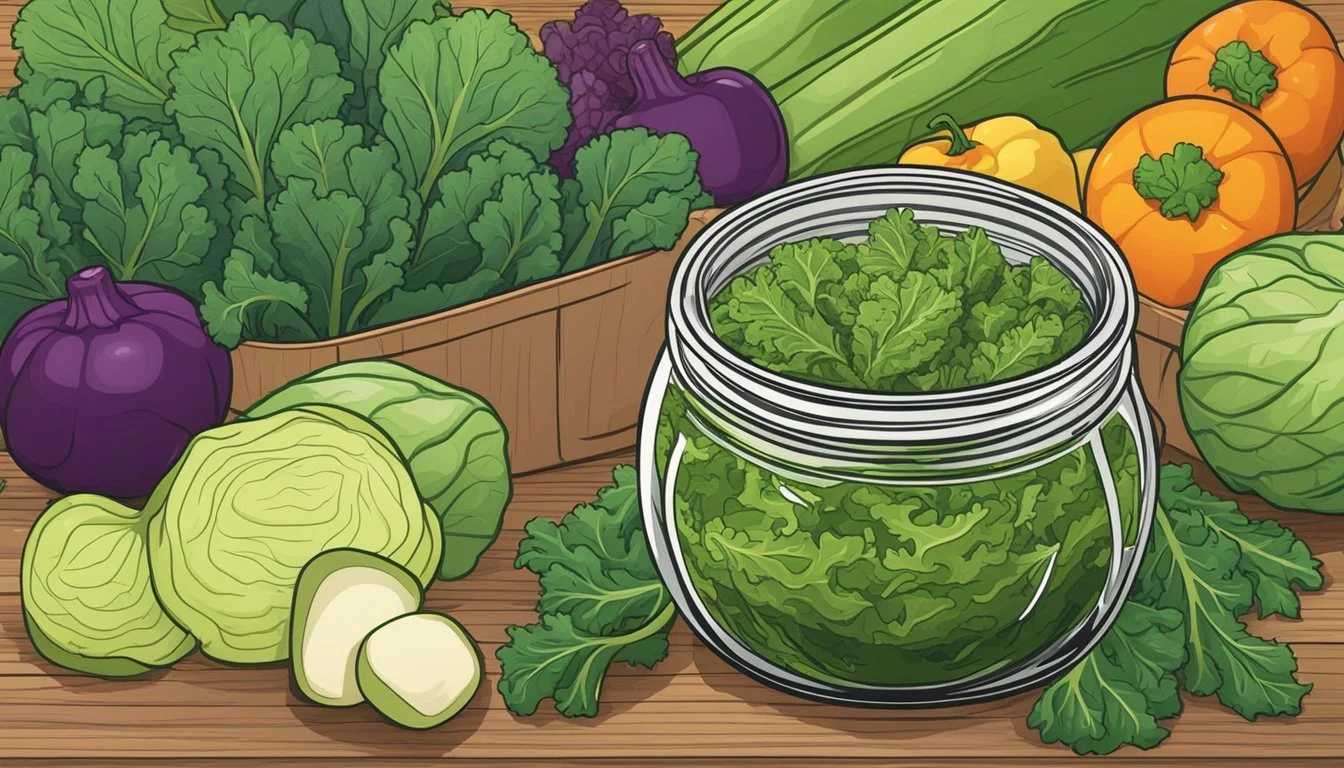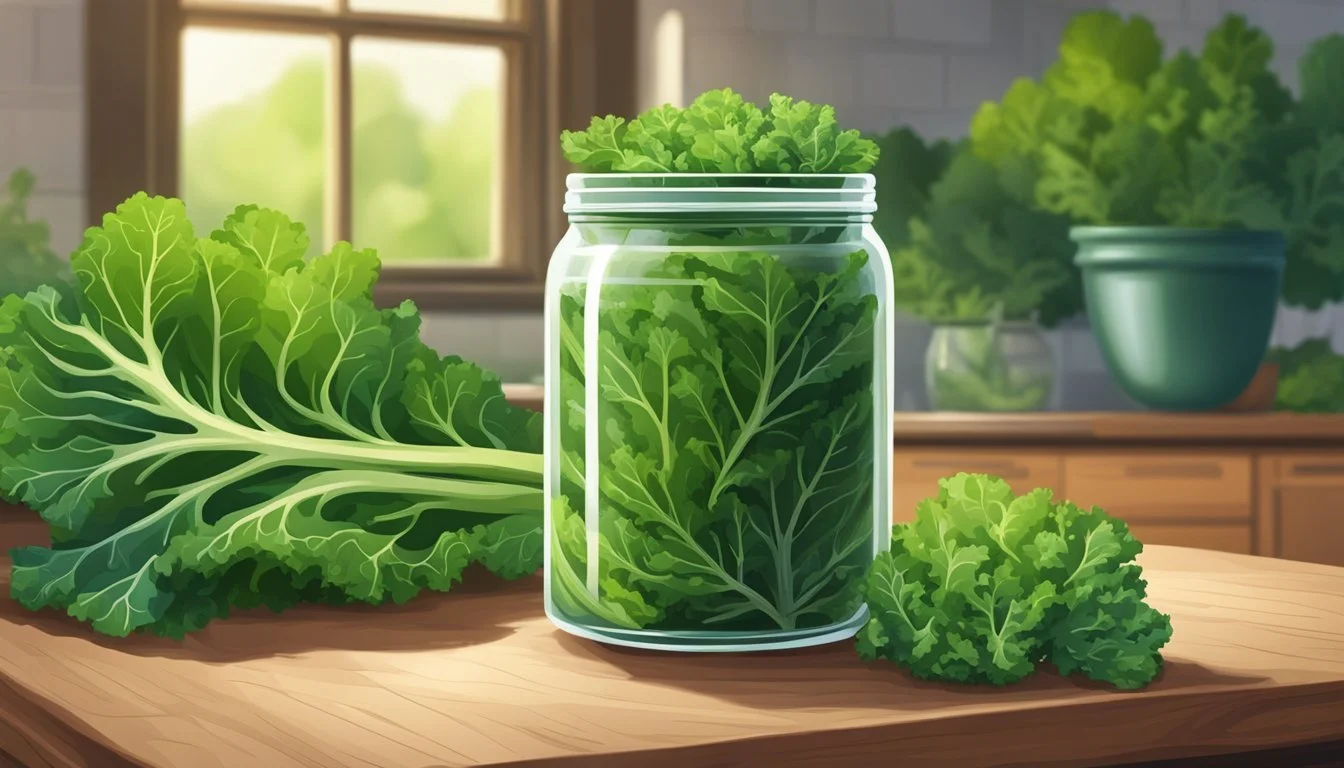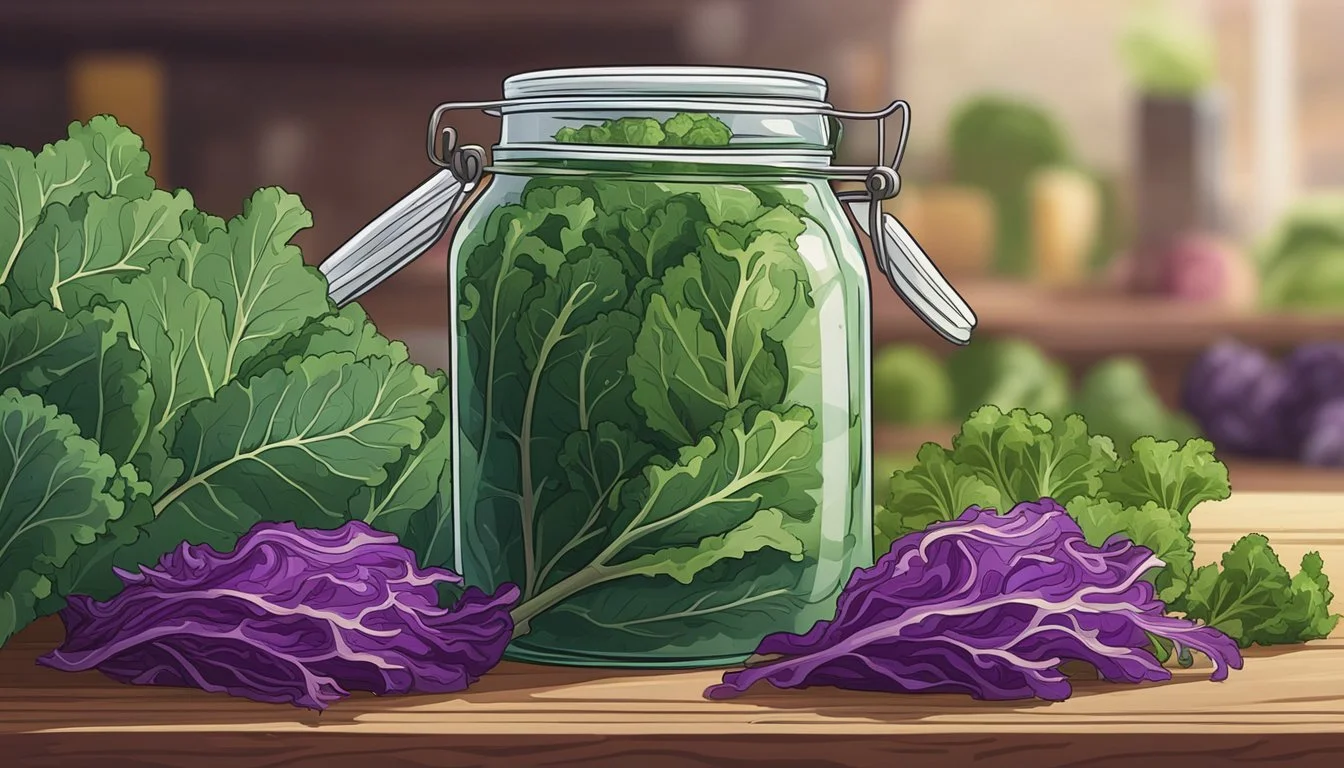Kale Stem Sauerkraut
Unleashing a Probiotic Powerhouse in Your Diet
Kale (What wine goes well with kale?) stem sauerkraut emerges as a unique twist on the traditional fermented cabbage dish, elevating the sustainability of kitchen routines by utilizing parts of the vegetable that typically go to waste. As a probiotic-rich condiment, this variation incorporates kale stems to enrich the classic sauerkraut with additional nutrients, texture, and a touch of bitterness that complements the tangy flavor profile.
Incorporating kale stems into sauerkraut not only enhances its nutritional value but also aligns with eco-conscious cooking practices, as it uses the entire kale plant. The stems, often discarded, are full of fiber and can introduce a delightful crunch to the sauerkraut. This green addition offers culinary enthusiasts a creative way to explore new flavors while contributing to a more sustainable food ecosystem.
The process of fermenting kale stems with cabbage for sauerkraut is similar to traditional methods, allowing the naturally present lactic acid bacteria to work its magic. By doing so, they transform the simple ingredients into a tangy, healthful condiment that is as good for the gut as it is for the palate. Easy to integrate into a variety of dishes, kale stem sauerkraut serves as a versatile component in both probiotic benefits and culinary applications.
Understanding Sauerkraut
Sauerkraut, a fermented cabbage dish, is recognized for its tangy flavor and probiotic richness.
Origins and Traditional Significance
Sauerkraut originated in China over 2,000 years ago, before spreading to Europe, particularly Germany, where it became a culinary staple. The process of fermentation, historically used to preserve food before refrigeration was available, is central to sauerkraut's creation.
Importance: Sauerkraut served as a food preservation method.
Connection to celebrations: Often linked to traditional festivities, denoting its cultural value.
Probiotic Properties
The fermentation of sauerkraut is a natural process that encourages the growth of good bacteria known as probiotics. These beneficial microbes arise from the lactic acid fermentation of the natural sugars in cabbage in an anaerobic environment.
Health benefits: Regular consumption of sauerkraut can promote gut health by enhancing digestive flora.
Probiotic content: Store-bought sauerkraut should be unpasteurized to retain its probiotic benefits.
Fermented foods like sauerkraut are increasingly recognized for their role in a healthy diet, given their ability to support a balanced gut microbiome.
Ingredients and Preparation
Creating Kale Stem Sauerkraut merges the traditional fermenting methods of sauerkraut with the often-overlooked kale stems, yielding a tangy and probiotic-rich condiment. This section outlines what is needed for the recipe and the initial steps for preparation.
Selecting Quality Vegetables
Choosing fresh, organic produce is essential for the best-tasting and healthiest sauerkraut. One should look for crisp kale, firm cabbage, and plump carrots. Each vegetable contributes to the complex flavor and nutritional content of the sauerkraut. The vegetables should be washed thoroughly to remove any dirt or residue, but peeling is not necessary as many nutrients are found in the skin.
The Role of Salt in Fermentation
Salt is not just a flavor enhancer; it is the key to successful fermentation. Specifically, sea salt is recommended for its minerals and lack of additives which could impede the fermentation process. During preparation, one should massage the salt into the vegetables, especially the kale stems, to help release their natural juices. This action creates the brine in which the vegetables will ferment. The general ratio to remember is 2-3 teaspoons of sea salt per 1/2 medium head of shredded cabbage. If adding additional ingredients like garlic for flavor, they can be crushed or sliced and included with the primary vegetables.
Kale Stem Sauerkraut Recipe
Making Kale Stem Sauerkraut is a straightforward process that results in a tangy, probiotic-rich condiment. This recipe highlights how to create a homemade sauerkraut with the added nutritional benefits and texture of kale stems.
Basic Steps for Homemade Sauerkraut
Ingredients:
1 medium head of green cabbage (about 2 pounds)
1 cup of kale stems, finely chopped
1-2 garlic cloves, minced (optional)
1 teaspoon red chili flakes (optional)
1 tablespoon sea salt without additives
Equipment:
Kitchen scale
Large mixing bowl
Mason jars (1-quart size preferred)
Instructions:
Prepare Cabbage: Weigh the cabbage using a kitchen scale to ensure accurate salt addition. Remove the outer leaves; set one aside for later use. Shred the rest of the cabbage finely.
Add Salt: Place the shredded cabbage in a large mixing bowl. Sprinkle sea salt over the cabbage. The salt-to-cabbage ratio is crucial; use 1 tablespoon of salt per 2 pounds of cabbage.
Massage the Cabbage: Using clean hands, massage the cabbage for about 5 to 10 minutes until it releases its liquid, creating a brine.
Incorporate Kale Stems: Add the finely chopped kale stems, minced garlic, and red chili flakes to the cabbage mixture. Mix thoroughly.
Incorporating Kale Stems
Prepare Kale Stems: Rinse the kale stems and chop them finely to ensure even fermentation and texture.
Layering: Alternately layer the massaged cabbage and kale stems into the mason jars to promote even distribution.
Compress: Press down the mixture firmly in the mason jar to eliminate air pockets. The brine should cover the vegetables when pressed. If necessary, use a fermentation weight to keep the vegetables submerged.
Seal and Ferment: Place the reserved outer cabbage leaf on top of the shredded mix to keep the smaller pieces submerged. Seal the mason jar with a clean lid. Allow the jar to sit at room temperature, out of direct sunlight, for at least 1 week or longer for desired tanginess. Check periodically to ensure the vegetables remain submerged, pressing down if they rise above the brine.
Storage: Once the sauerkraut reaches the preferred level of fermentation, store the mason jars in the refrigerator to halt the fermentation process. The Kale Stem Sauerkraut can be enjoyed immediately but will continue to develop flavor over time.
Enhancing Flavor and Nutritional Value
Kale stem sauerkraut not only delivers a uniquely tangy flavor but also offers a wealth of nutritional benefits due to the fermentation process. Utilizing the entire kale plant, including the stems, maximizes nutrients and ensures a satisfyingly crunchy texture.
Additional Ingredients
To enhance the flavor of kale stem sauerkraut, additional ingredients can be incorporated. Common choices include:
Garlic: Adds depth and aroma.
Caraway seeds: Bring a distinct earthy tone.
Juniper berries: Introduce a fresh, piney note.
These ingredients not only contribute complex flavors but also contain compounds that may support the fermentation process. When prepping the mixture, a kraut pounder can be particularly useful for releasing juices from the kale stems and compacting the sauerkraut within the jar. This step is essential to create the anaerobic environment necessary for lactic acid bacteria to thrive.
Health Benefits of Fermented Cabbage
Fermented cabbage, such as kale stem sauerkraut, is more than merely a side dish—it's a powerhouse of nutrition:
Rich in Vitamins: It provides a good source of vitamin C and K, essential for immune function and bone health.
High in Fiber: Sauerkraut contains dietary fiber, important for digestion.
Antioxidants and Enzymes: The fermentation process boosts antioxidant levels and generates enzymes that can aid in gut health.
Probiotics: Raw, fermented sauerkraut is packed with probiotics that help maintain a healthy balance in the digestive system.
During fermentation, the addition of vinegar may not be necessary, as the naturally present lactic acid bacteria produce their own acidic environment, effectively turning the sugars into beneficial acids and enzymes. The resulting tangy taste is not only appealing but also a sign of a successfully fermented condiment.
The Fermentation Process
Transforming kale stems into a probiotic-rich sauerkraut involves a meticulous fermentation process that thrives under optimal conditions and proper monitoring. This method leverages the power of lactic acid bacteria to preserve and flavor the kale, creating a tangy condiment.
Optimal Fermentation Conditions
Temperature: The ideal range for fermenting kale stem sauerkraut is between 65°F and 72°F. This range supports the growth of desirable bacteria while inhibiting unwanted pathogens. It's important to maintain a consistent temperature throughout the fermentation period.
Container: A clean quart jar or a similar fermenting vessel is used to house the kale and other ingredients. The size of the jar should be enough to leave some headspace at the top while containing the kale and brine.
Weight: A fermentation weight is essential to keep the kale stems submerged in the brine, preventing exposure to air that can lead to spoilage.
Air Lock Device: An air lock device can be fitted to the container, allowing carbon dioxide to escape without letting outside air in. This helps in maintaining an anaerobic environment optimal for fermentation.
Monitoring and Controlling Fermentation
Time: Typically, the fermentation process for kale stem sauerkraut takes about 1 to 4 weeks. It's important to observe the changes in the produce during this time, as the duration can affect tanginess and probiotic content.
Burping: If a standard lid is used instead of an air lock, the jar needs to be 'burped' daily to release built-up pressure. This step is crucial to prevent the jar from potentially cracking.
Throughout the fermentation, the sauerkraut should be checked regularly for signs of improper fermentation, such as mold or an off-putting smell. By adjusting the ambient temperature, weight placement, or brine levels, the fermentation process can be controlled to ensure a delicious and safe outcome.
Storage and Preservation
When it comes to storing Kale Stem Sauerkraut, both short-term and long-term options are available that ensure the product retains its probiotic properties and tangy flavor. Proper storage also prevents mold growth and spoilage, extending the shelf life of this nutritious condiment.
Short-Term and Long-Term Storage Options
For short-term storage, placing Kale Stem Sauerkraut in a refrigerator is essential. The cooler temperatures between 32-40°F (0-4°C) are ideal as they slow down the fermentation process, preserving the sauerkraut's texture and preventing over-fermentation. To achieve optimal long-term preservation, one can utilize either freezing or canning methods. A root cellar may also serve as a suitable environment for extending the shelf life due to its naturally cool and stable temperature.
Refrigerator: Best for everyday use.
Frozen: Suitable for several months to a year.
Canning: Ensures longevity over a year.
Root Cellar: Ideal for maintaining flavor and texture for a few months.
Preventing Mold and Spoilage
Kale Stem Sauerkraut should always be kept in conditions that prevent the growth of mold and the risk of spoilage. This includes ensuring that the sauerkraut is always covered by its juice, which acts as a barrier to airborne contaminants. The use of vinegar in the brine can also increase acidity, which deters mold. Using tap water should be avoided where possible, as the chlorine can inhibit the fermentation process and may lead to the growth of unwanted bacteria. Sauerkraut should always be stored in clean, airtight containers to provide an oxygen-free environment that is hostile to mold.
Keep submerged in brine.
Use brine with vinegar to prevent mold.
Avoid tap water to maintain healthy fermentation.
Store in airtight containers to eliminate oxygen exposure.
Culinary Uses of Kale Stem Sauerkraut
Kale stem sauerkraut adds a tangy flavor and a pleasant crunch to diverse dishes. Its probiotic qualities contribute to healthier meal options.
Pairing with Main Dishes
Kale stem sauerkraut can be served alongside a variety of main dishes to enhance their flavor profile. Its sharp, zesty taste pairs well with:
Meats: A topping for rich meats to add a probiotic punch.
Stir-fries: As a finishing element to provide an extra tang and texture contrast.
Incorporation into Salads and Sandwiches
The unique qualities of kale stem sauerkraut make it an excellent addition to salads and sandwiches, where it can provide:
Salads: A textural variety and a flavor boost to green and grain-based salads.
Recipe twist: Mix into a vinaigrette dressing for a tangy infusion.
Sandwiches: A contrasting element that complements meats and cheeses with its sour notes.
Bold integration: Layer into deli sandwiches or wraps for added complexity and gut-friendly benefits.
Expanding the Fermentation Horizon
Fermentation enthusiasts are embracing the versatility of vegetables to create probiotic-rich, savory condiments. The process is not limited to traditional cabbage sauerkraut but can extend to inventive variations using a multitude of vegetables.
Exploring Other Fermented Vegetables
Fermented vegetables offer a spectrum of flavors and health benefits. Ingredients such as kale stems, when fermented, become a tangy condiment rich in probiotics. By incorporating various vegetables, individuals can tailor the nutrient profile and taste to their preference. Vegetables commonly used in fermentation, in addition to cabbage, include:
Carrots: adding a sweet, crunchy element.
Beets: known for their deep, earthy flavors and vibrant color.
Cucumbers: which transform into pickles with a satisfying, crisp texture.
Broccoli stems: yielding a milder version of the familiar sauerkraut flavor.
Experimentation with different herbs can also enhance the nutritional value and provide unique taste experiences.
Comparing Sauerkraut with Kimchi and Pickles
While sauerkraut is traditionally made from fermented cabbage, its methods share similarities with those used to create other fermented foods like kimchi and pickles. Below is a comparative overview of these fermented favorites:
Feature Sauerkraut Kimchi Pickles Base Vegetable Cabbage Napa Cabbage or Other Vegetables Cucumbers Flavor Profile Tangy, Sour Spicy, Umami Tangy, Sour or Sweet Typical Herbs/Spices Caraway Seeds, Juniper Berries Chili Pepper, Garlic, Ginger Dill, Garlic Fermentation Time Several Weeks Days to Months Varies
Kimchi, hailing from Korea, incorporates a variety of spices and often includes fish sauce for depth. It can have a range from mild to fiery heat. Meanwhile, pickles, especially the versions known as kosher dill pickles, typically soak in a brine with garlic and dill weed to achieve their distinctive flavor. All methods endorse the growth of beneficial bacteria and involve salting the vegetables to draw out moisture and create an ideal fermenting environment.
Maintaining a Healthy Gut Microbiome
A healthy gut microbiome is essential for optimal digestion and overall health, with probiotic-rich foods like kale stem sauerkraut playing a significant role.
Impact of Probiotic Foods on Digestion
Probiotic foods contribute to a healthy gut microbiome by introducing beneficial bacteria that enhance digestive health. Kale stem sauerkraut, rich in probiotics, is known for its health benefits that include improving bowel movement regularity and alleviating common digestive disorders. These live microorganisms help restore the natural balance of gut bacteria, which can be disrupted by poor diet, stress, or antibiotics.
Table: Probiotics and Digestive Benefits
Probiotic Content Digestive Benefits Lactobacillus Improves bowel regularity and helps in lactose digestion Bifidobacterium Reduces symptoms of IBS and other gastrointestinal disorders
Consuming sauerkraut made from kale stems not only diversifies the microbiome but also ensures that digestion is smooth, potentially preventing the development of chronic diseases related to the gut.
Fermented Foods in a Balanced Diet
Incorporating fermented foods like sauerkraut into a balanced diet can support a healthy gut microbiome. Such foods are probiotic-rich, providing the gut with beneficial bacteria which, in turn, can enhance immune function and contribute to overall energy levels.
List of Benefits from Fermented Foods:
Boost immune system: Fermented vegetables fortify the gut-associated lymphoid tissue (GALT).
Increase energy: A well-balanced gut microbiome facilitates efficient nutrient absorption, leading to better energy management.
Manage calories: Fermented foods are typically low in calories yet high in nutrients, aiding in weight management.
Regular consumption of fermented foods, when paired with a wholesome diet, can offer essential health benefits without contributing excess calories, supporting both gut health and general wellness.
Tips and Best Practices
Making Kale Stem Sauerkraut is an art that involves the right equipment, mastering the brine, and handling common issues with expertise.
Choosing the Right Equipment
One should select a clean, non-reactive container, like a mason jar, that is suitable for fermentation. The use of an air lock device is recommended to allow gases to escape while preventing unwanted contaminants. A weight is essential to keep the vegetables submerged under the brine to avoid mold growth.
Mastering the Perfect Brine Ratio
Creating the perfect brine is critical for fermentation. A ratio of 1.5 tablespoons of sea salt or Celtic sea salt to 1 quart of tap water (ensuring it's non-chlorinated) creates an environment for probiotics to thrive. Additionally, ensuring that the brine fully covers the kale stems and other vegetables will prevent unwanted bacterial growth.
Troubleshooting Common Issues
Ensuring the brine level is maintained throughout fermentation prevents mold, which is the common culprit of failed ferments. If one spots mold, they should remove it immediately since it can affect flavor and safety. One should also ensure that tap water free of chlorine is used, as it can inhibit fermentation. If kale stems float above the brine, a fermentation weight or a clean cabbage leaf can be used to keep them submerged.


